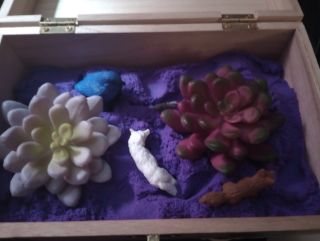MINDFULNESS- What Is a Serenity Box? The sand tray is a mindful, sensory-soothing practice.

KEY POINTS-
- Serenity boxes are a creative coping strategy and mindfulness practice.
- Sand tray activities have been used within a number of therapy traditions dating back to Carl Jung.
- Serenity boxes combine elements of sand tray with distress tolerance and emotion regulation skills.
My mind raced. It had been a relatively high-stress weekend, and I craved a way to relax. Yet, for me and a lot of people I know, trying hard to relax can be, well, stressful. I grabbed some sand, a wooden box, and a few small trinkets and went to work.

I ran my fingers through the sensory sand, noticing the texture. Dipping the purple and blue swirls together in the little crate while watching where each bit landed had an enchanting effect. The colors created a satisfying image that I could change. I placed little plastic flowers along with wolf and fox miniatures, and standing guard laid an oversized blue bird. A holographic guitar pick made a nice rake, moving the scenery. Curiosity filled my mind as my feet felt more grounded. My stress became irrelevant.
AfriPrime App link: FREE to download...
I left with a treasure chest of sorts, a serenity box.
Serenity Box
When mammals feel safe, we play. In times of danger, there is no time to frolic. Unfortunately for our species today, the social and financial threats we face last far longer than the lions and bears that our fellow encounter. We can forget how to play.
Serenity boxes combine elements of creativity, play, sand tray (a play therapy technique involving creating a scene with miniatures in a sandbox), and mindfulness for a calming and healing activity. While not therapy, it is an activity holding several therapeutic aspects.
Over the years, I have created several serenity boxes ranging from a butterfly planet fantasy to a scene of greenery, a fairy, and ducks. For me, each serves a purpose. One channels my worries into well-wishes by crafting a scene reminiscent of a hurting friend as I meditated on these well-wishes in its creation. Another box is a vision of a fantasy place, serving the purpose of self-soothing. It is one I open now and then to help myself center.
I have also used off-shoots of this exercise as a therapist.
Sand in Therapy
Sand has been a tradition in specific psychotherapies dating back to the 1920s. Psychoanalyst Carl Jung saw the use of miniatures arranged in a sand tray as a potential playground for individuals to work through inner conflicts and trauma (Frame, 2003). A client would be presented with a sandbox alongside hundreds of little sculptures to assist in expressing themselves and answering open prompts.
Today, the sand tray remains a common therapy strategy, particularly in play therapy. Variations of the technique encompass everything from non-directed engagement with the sand tray to a space where clients can share a trauma narrative. It has been used successfully for endeavors ranging from helping combat veterans process traumatic memories (Kern Popejoy and colleagues, 2021) to assisting preschool children with behavioral challenges (Abdollahi and Abolmaai, 2018). Sand tray interventions can also integrate well with evidence-based treatments like cognitive behavioral therapy (CBT) (Remey, 2024).
Some have also compared the tracing of the sand with reconnection to the earth. Zen gardens are meditation tools utilizing sand reaching beyond psychotherapy.
Serenity Boxes
Creating a serenity box also engages therapy-related skills. The composition of a serenity box can be a mindfulness practice in focusing one-mindedly on the task and observing the sensory components.
Similarly, with meditation sand and sometimes colorful objects, the project can serve as a sensory-soothing tool.
A serenity box can be used as an anchor for difficult days, especially for individuals who have experienced trauma and neurodivergent individuals.
Serenity boxes also strengthen some of the skills taught in dialectical behavioral therapy, including distress tolerance, emotion regulation, and mindfulness skills.
I am thankful for my serenity box.
AfriPrime App link: FREE to download...
- Questions and Answers
- Opinion
- Motivational and Inspiring Story
- Technology
- Live and Let live
- Focus
- Geopolitics
- Military-Arms/Equipment
- Sicurezza
- Economy
- Beasts of Nations
- Machine Tools-The “Mother Industry”
- Art
- Causes
- Crafts
- Dance
- Drinks
- Film/Movie
- Fitness
- Food
- Giochi
- Gardening
- Health
- Home
- Literature
- Music
- Networking
- Altre informazioni
- Party
- Religion
- Shopping
- Sports
- Theater
- Health and Wellness
- News
- Culture

